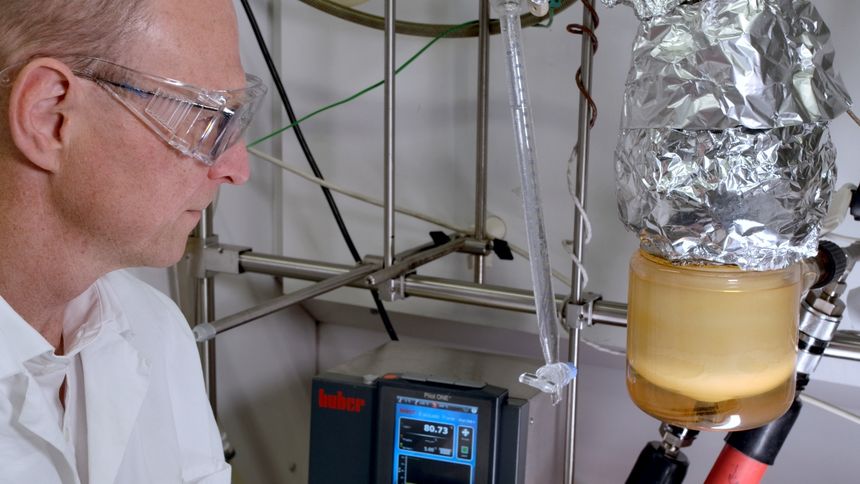
Sonny Schepers is considered the (now proud) founding father of the E-boiler project at the Industrial Park van Chemelot. He works at USG Industrial Utilities, which handles the procurement, production, distribution and sale of electricity, steam, natural gas, nitrogen, compressed air and metered air and various kinds of water for companies at the industrial complex.
Schepers started following discussions about sustainability at conferences or meetings with interest about five years ago. ” Often it was about converting green electricity into heat. That way you could avoid having to use fossil natural gas to generate heat. We were hearing that everywhere but I still wasn’t seeing it happening anywhere.”
Which is why Schepers decided to conduct a rigorous feasibility study of where USG might be able to make use of it. “Ultimately, we came to the conclusion that a 26 bar electric steam boiler would fit really well into the steam system at USG. It’s possible to install a large electricity connection at the proposed location, as well as a 26 bar steam connecting pipeline, and boiler feed water is available there as well.” The conclusion his research drew was that an electric steam boiler would be feasible here. Still, there were some doubts: “We could see that it made sense and we had come up with a reasonable business case, but it is nonetheless tricky to assess objectively what the value of that would be in the future.”
CO²-saving technologies
In order to be able to gain more financial security, a successful lobbying effort was mounted to incorporate the electric steam boiler into the national SDE++ subsidy scheme for renewable energy-generating and CO²-saving technologies.
Since then, the basic engineering is almost finished and an order for the electric boiler has been placed in Norway. Although an e-boiler is not a novelty as such, it is certainly quite special that it is being fitted into an existing system on an industrial scale. Schepers says with a smile: “That creates a bit of a stir and it always takes a while before everyone gets on board.”
Schepers compares the boiler to a kettle on a kitchen counter, except on an industrial scale – about seven or eight meters high. They already have one installed at Eneco’s district heating plant. That has a muffler because the boiler sometimes has to blow off some steam when starting up. It also comes with an electric superheater so that the steam temperature can be cranked up even higher.
Sonny Schepers: “You could say that it is not very efficient to use electricity to generate heat. In fact, if this electricity was generated with natural gas or coal, then it would be better to burn coal or gas straight away. That’ s why electric boilers were only used where you didn’t have any other alternative like on board ships, or if you had an abundant supply of electricity. Today, the electrical steam boiler is very interesting because you are advancing towards a system run on sun and wind. You get periods of surplus electricity that you don’t get from fossil fuels but instead from sun and wind. That’s the payoff. The technology is already proven itself in practice, but we are going to apply it in an innovative way as a hybrid system as part of our steam system. The idea here is that it allows us to be very flexible. The boiler can be turned on at the push of a button, so that we don’t need to use our natural gas-fired steam boilers so much.”

Paper mills
Industrial complexes and energy-intensive parties such as paper mills are also expressing a lot of interest. Schepers has noticed the waiting times at e-boiler manufacturers are growing. “In the beginning, several large power companies from the Netherlands approached us to see if they could step into this project because it’s really interesting for power companies, as they understand the value of being flexible. In the end, we preferred to develop this project on our own. We work with operators here in five shifts; it’s also a demo project for us to get those operators used to everything. Now they know: steam is needed so I switch on the gas boiler. But we are steadily going to have more and more of a choice as to whether we produce that steam with electricity or with natural gas.”
Electrification
As it happens, it will be some time before the e-boiler will be up and running. Cables and transformers are hard to come by at the moment, and another project must be completed at Chemelot before things can get rolling.
Then the key question remains: What is the payoff? Sonny Schepers: “I’m not going to quote any concrete numbers. Ultimately, the idea is that you make money because you are able to avoid using natural gas whenever the price of electricity is very low. If there is a lot of sun and a lot of wind and the prices are low as a consequence, then you turn on the E-boiler and so avoid having to use natural gas and the costs of CO² emissions. That’s a significant portion of the return on investment. Apart from that, the great flexibility of the e-boiler has operational value for our steam system and plenty of potential in terms of financial value in the electricity market. But more importantly, this will be our first concrete step towards the industrial electrification, and in turn, the sustainability of Chemelot. “

